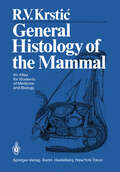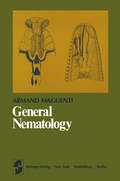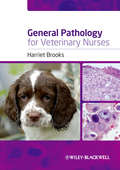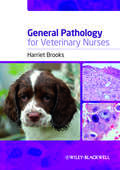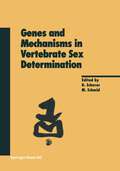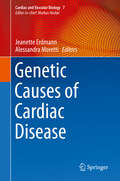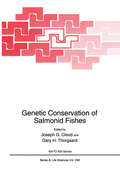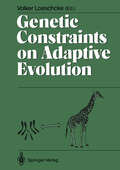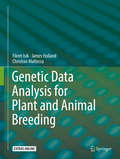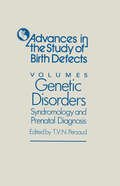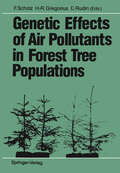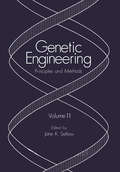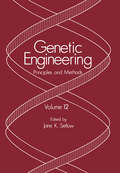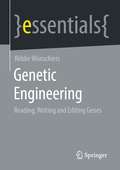- Table View
- List View
General Histology of the Mammal: An Atlas for Students of Medicine and Biology
by Radivoj V. KrsticWith a Foreword by Reiter R.J. Translated by Forster, S.
A General History of Quadrupeds: The Figures Engraved on Wood
by Thomas BewickIn the late eighteenth century, the British took greater interest than ever before in observing and recording all aspects of the natural world. Travelers and colonists returning from far-flung lands provided dazzling accounts of such exotic creatures as elephants, baboons, and kangaroos. The engraver Thomas Bewick (1753–1828) harnessed this newfound interest by assembling the most comprehensive illustrated guide to nature of his day. A General History of Quadrupeds, first published in 1790, showcases Bewick’s groundbreaking engraving techniques that allowed text and images to be published on the same page. From anteaters to zebras, armadillos to wolverines, this delightful volume features engravings of over four hundred animals alongside descriptions of their characteristics as scientifically understood at the time. Quadrupeds reaffirms Bewick’s place in history as an incomparable illustrator, one whose influence on natural history and book printing still endures today.
A General History of Quadrupeds: The Figures Engraved on Wood
by Thomas BewickIn the late eighteenth century, the British took greater interest than ever before in observing and recording all aspects of the natural world. Travelers and colonists returning from far-flung lands provided dazzling accounts of such exotic creatures as elephants, baboons, and kangaroos. The engraver Thomas Bewick (1753–1828) harnessed this newfound interest by assembling the most comprehensive illustrated guide to nature of his day. A General History of Quadrupeds, first published in 1790, showcases Bewick’s groundbreaking engraving techniques that allowed text and images to be published on the same page. From anteaters to zebras, armadillos to wolverines, this delightful volume features engravings of over four hundred animals alongside descriptions of their characteristics as scientifically understood at the time. Quadrupeds reaffirms Bewick’s place in history as an incomparable illustrator, one whose influence on natural history and book printing still endures today.
A General History of Quadrupeds: The Figures Engraved on Wood
by Thomas BewickIn the late eighteenth century, the British took greater interest than ever before in observing and recording all aspects of the natural world. Travelers and colonists returning from far-flung lands provided dazzling accounts of such exotic creatures as elephants, baboons, and kangaroos. The engraver Thomas Bewick (1753–1828) harnessed this newfound interest by assembling the most comprehensive illustrated guide to nature of his day. A General History of Quadrupeds, first published in 1790, showcases Bewick’s groundbreaking engraving techniques that allowed text and images to be published on the same page. From anteaters to zebras, armadillos to wolverines, this delightful volume features engravings of over four hundred animals alongside descriptions of their characteristics as scientifically understood at the time. Quadrupeds reaffirms Bewick’s place in history as an incomparable illustrator, one whose influence on natural history and book printing still endures today.
A General History of Quadrupeds: The Figures Engraved on Wood
by Thomas BewickIn the late eighteenth century, the British took greater interest than ever before in observing and recording all aspects of the natural world. Travelers and colonists returning from far-flung lands provided dazzling accounts of such exotic creatures as elephants, baboons, and kangaroos. The engraver Thomas Bewick (1753–1828) harnessed this newfound interest by assembling the most comprehensive illustrated guide to nature of his day. A General History of Quadrupeds, first published in 1790, showcases Bewick’s groundbreaking engraving techniques that allowed text and images to be published on the same page. From anteaters to zebras, armadillos to wolverines, this delightful volume features engravings of over four hundred animals alongside descriptions of their characteristics as scientifically understood at the time. Quadrupeds reaffirms Bewick’s place in history as an incomparable illustrator, one whose influence on natural history and book printing still endures today.
A General History of Quadrupeds: The Figures Engraved on Wood
by Thomas BewickIn the late eighteenth century, the British took greater interest than ever before in observing and recording all aspects of the natural world. Travelers and colonists returning from far-flung lands provided dazzling accounts of such exotic creatures as elephants, baboons, and kangaroos. The engraver Thomas Bewick (1753–1828) harnessed this newfound interest by assembling the most comprehensive illustrated guide to nature of his day. A General History of Quadrupeds, first published in 1790, showcases Bewick’s groundbreaking engraving techniques that allowed text and images to be published on the same page. From anteaters to zebras, armadillos to wolverines, this delightful volume features engravings of over four hundred animals alongside descriptions of their characteristics as scientifically understood at the time. Quadrupeds reaffirms Bewick’s place in history as an incomparable illustrator, one whose influence on natural history and book printing still endures today.
A General History of Quadrupeds: The Figures Engraved on Wood
by Thomas BewickIn the late eighteenth century, the British took greater interest than ever before in observing and recording all aspects of the natural world. Travelers and colonists returning from far-flung lands provided dazzling accounts of such exotic creatures as elephants, baboons, and kangaroos. The engraver Thomas Bewick (1753–1828) harnessed this newfound interest by assembling the most comprehensive illustrated guide to nature of his day. A General History of Quadrupeds, first published in 1790, showcases Bewick’s groundbreaking engraving techniques that allowed text and images to be published on the same page. From anteaters to zebras, armadillos to wolverines, this delightful volume features engravings of over four hundred animals alongside descriptions of their characteristics as scientifically understood at the time. Quadrupeds reaffirms Bewick’s place in history as an incomparable illustrator, one whose influence on natural history and book printing still endures today.
General Pathology for Veterinary Nurses
by Harriet BrooksA good understanding of pathology will turn a competent veterinary nurse into an outstanding one. Harriet Brooks. This is one of the first books on general pathology designed specifically for veterinary nurses and veterinary nursing students. Pathology underpins all you do as a veterinary nurse. Knowledge of the general pathological processes will give you a deeper understanding of every aspect of an animal’s health. Building on your prior knowledge of anatomy, physiology and biochemistry, the book explains the pathological changes that occur in sick animals. It describes the various disease processes and shows you how to relate them to clinical presentation, diagnosis and prognosis, and treatment rationales. This book will give you the knowledge and confidence to develop your role within the veterinary team. Designed as a concise, easy to read textbook, it includes: Detailed illustrations to explain the science behind the pathological processes Summary boxes of key information to aid revision A ‘test yourself’ section at the end of each chapter
General Pathology for Veterinary Nurses
by Harriet BrooksA good understanding of pathology will turn a competent veterinary nurse into an outstanding one. Harriet Brooks. This is one of the first books on general pathology designed specifically for veterinary nurses and veterinary nursing students. Pathology underpins all you do as a veterinary nurse. Knowledge of the general pathological processes will give you a deeper understanding of every aspect of an animal’s health. Building on your prior knowledge of anatomy, physiology and biochemistry, the book explains the pathological changes that occur in sick animals. It describes the various disease processes and shows you how to relate them to clinical presentation, diagnosis and prognosis, and treatment rationales. This book will give you the knowledge and confidence to develop your role within the veterinary team. Designed as a concise, easy to read textbook, it includes: Detailed illustrations to explain the science behind the pathological processes Summary boxes of key information to aid revision A ‘test yourself’ section at the end of each chapter
Genes and Mechanisms in Vertebrate Sex Determination (Experientia Supplementum #91)
by Gerd SchererFollowing an opening chapter by the late Susumu Ohno on paralogues of sex-determining genes, the five best-studied genes essential for early mammalian gonadal development are portrayed in detail: SF-1 and WT1 and their roles in early events in gonadal development, SRY and SOX9 in testis determination, and the anti-testis gene DAX-1. Subsequent chapters look at the roles of these genes in sex determination in marsupial mammals, birds, reptiles, amphibians and fish, and review the different sex-determining mechanisms, genetic and environmental, that operate in these different vertebrate classes. Two insights emerge: one, that the same basic set of genes appears to operate during early gonadal development in all vertebrates, despite the differences in mechanisms; the other, that sex determination in vertebrates results from a complex network of regulatory interactions and not from a simple hierarchical cascade of gene actions.
Genetic Basis for Respiratory Control Disorders
by Claude GaultierBringing together top-level contributions on all aspects of the subject, this book provides an overview of the recent advances in the genetics of respiratory control in health and disease. It also shows how combined studies in humans and mouse models have helped to improve our understanding of the mechanisms that underlie genetically determined respiratory control disorders with the goal of developing new therapeutic interventions.
Genetic Causes of Cardiac Disease (Cardiac and Vascular Biology #7)
by Jeanette Erdmann Alessandra MorettiThis book provides a comprehensive summary of the latest developments in the field of the genomics of cardiac disease. Written and edited by leading clinicians and scientists involved in the analysis and therapy of genetic cardiac disorders, it discusses the genetic causes of a variety of cardiac diseases, such as the complex genetics and etiology of congenital heart diseases. It also explores sex differences in prevalent diseases, genetics-based therapeutic strategies and the use of various animal models and alternatives. The book is intended for research scientists and clinical scientists in the cardiovascular field, human geneticists and cardiologists.
Genetic Conservation of Salmonid Fishes (Nato Science Series A: #248)
by Joseph G. Cloud Gary H. ThorgaardAs the human population increases and nations become more industrialized, the habitat and water quality required for the survival of fish continues to decline. In addition to these environmental factors, fish populations are directly or potentially affected by harvesting, enhancement programs and introgression with hatchery-propagated or transgenic fish. To our knowledge no other scientific meeting has been assembled to consider the breadth of the problem, to review the technology that is presently available for the preservation of the germ plasm of salmonid stocks and to identify the scientific advances that are required to overcome the problems. Because many salmonids have spawning grounds within the confines of a specific region or county but will spend a large portion of their life cycle within the territorial waters of other countries or in the open ocean, the preservation of unique genes or gene pools in these animals requires international cooperation. This scientific meeting has provided a forum in which to discuss the problems, evaluate the present methods or technology for addressing the problems and suggest new directions or innovations that need to be implemented. During this meeting we limited our discussion to salmonid fishes. However, the general conclusions about the factors that affect the population dynamics of fish stocks and the technical aspects concerning the preservation of germ plasm will be applicable to other fish species.
Genetic Constraints on Adaptive Evolution
by Volker LoeschckeGenetic constraints on adaptive evolution can be understood as those genetic aspects that prevent or reduce the potential for natural selection to result in the most direct ascent of the mean phenotype to an optimum. The contributions to this volume emphasize how genetic aspects in the transmission of traits constrain adaptive evolution. Approaches span from quantitative, population, ecological to molecular genetics. Much attention is devoted to genetic correlations, to the maintenance of quantitative genetic variation, and to the intimate relation between genetics, ecology, and evolution. This volume addresses all evolutionary biologists and explains why they should be wary of evolutionary concepts that base arguments purely on phenotypic characteristics.
Genetic Data Analysis for Plant and Animal Breeding
by Fikret Isik James Holland Christian MalteccaThis book fills the gap between textbooks of quantitative genetic theory, and software manuals that provide details on analytical methods but little context or perspective on which methods may be most appropriate for a particular application. Accordingly this book is composed of two sections. The first section (Chapters 1 to 8) covers topics of classical phenotypic data analysis for prediction of breeding values in animal and plant breeding programs. In the second section (Chapters 9 to 13) we provide the concept and overall review of available tools for using DNA markers for predictions of genetic merits in breeding populations. With advances in DNA sequencing technologies, genomic data, especially single nucleotide polymorphism (SNP) markers, have become available for animal and plant breeding programs in recent years. Analysis of DNA markers for prediction of genetic merit is a relatively new and active research area. The algorithms and software to implement these algorithms are changing rapidly. This section represents state-of-the-art knowledge on the tools and technologies available for genetic analysis of plants and animals. However, readers should be aware that the methods or statistical packages covered here may not be available or they might be out of date in a few years. Ultimately the book is intended for professional breeders interested in utilizing these tools and approaches in their breeding programs. Lastly, we anticipate the usage of this volume for advanced level graduate courses in agricultural and breeding courses.
Genetic Disorders, Syndromology and Prenatal Diagnosis (Advances in the Study of Birth Defects #5)
by T. V. N. PersaudBirth defects have assumed an importance even greater now than in the past because infant mortality rates attributed to congenital anomalies have declined far less than those for other causes of death, such as infectious and nutritional diseases. As many as 50 % of all pregnancies terminate as miscarriages, and in the majority of cases this is the result of faulty intrauterine development. Major congenital malformations are present in at least 2 % of all liveborn infants, and 22 % of all stillbirths and infant deaths are associated with severe congenital anomalies. Not surprisingly, there has been a great proliferation of research into the problems of developmental abnormalities over the past few decades. This series, Advances in the Study of Birth Defects, was conceived in order to provide a comprehensive focal source of up-to-date information for physi cians concerned with the health of the unborn child and for research workers in the fields of fetal medicine and birth defects. The first four volumes featured recent experimental work on selected areas of high priority and intensive investigation, including mechanisms of teratogenesis, teratological evaluation, molecular and cellular aspects of abnormal development, and neural and behavioural teratology. It seems logical and timely that the clinical aspects should now be presented. Accordingly, leading experts were invited to review a broad range of common problems from the standpoint of embryology, aetiology, clinical manifestations, diagnosis and management. This volume deals with genetic disorders and prenatal diagnosis.
Genetic Effects of Air Pollutants in Forest Tree Populations: Proceedings of the Joint Meeting of the IUFRO Working Parties Genetic Aspects of Air Pollution Population and Ecological Genetics Biochemical Genetics held in Großhansdorf, August 3–7, 1987
by Florian Scholz Hans-Rolf Gregorius Dag RudinAir pollutants provide environmental conditions that drastically differ in many respects from those to which forest trees are naturally adapted. Leading experts in the field here consider these questions of immediate relevance arising from the changing environment: (1) Do air pollutants introduce effects of selection that differ from those known for populations that are not subject to such stress conditions? (2) If air pollutants introduce quantitatively or even qualitatively novel selective effects, which consequences might arise from the adaptation of forest tree populations to the present conditions as well as for the preservation of adaptability to future conditions? In addition to these questions, concepts for preservation of genetic resources are discussed.
Genetic Engineering: Principles and Methods (Genetic Engineering: Principles and Methods #11)
by Jane K. SetlowGenetic Engineering: Principles and Methods (Genetic Engineering: Principles and Methods #15)
by Jane K. SetlowThe current volume covers human gene therapy, improving the nutritional value of maize, restriction-modification enzymes, and eight other subjects.
Genetic Engineering: Principles and Methods (Genetic Engineering: Principles and Methods #20)
by Jane K. SetlowGenetic Engineering: Principles and Methods (Genetic Engineering: Principles and Methods #18)
by Jane K. SetlowVolume 18 explores the latest advances in recombinant DNA molecule techniques and how they are revolutionizing basic research in biology. Chapters discuss obtaining good expression of genetically engineered pest-resistant genes introduced in crop plants, cloning DNAs containing palindromes, and identifying genes by 3' terminal exon trapping and much more.
Genetic Engineering: Principles and Methods (Genetic Engineering: Principles and Methods #12)
by Jane K. SetlowGenetic Engineering: Principles and Methods (Genetic Engineering: Principles and Methods #14)
by Jane K. SetlowGenetic Engineering: Reading, Writing and Editing Genes (essentials)
by Röbbe WünschiersThis essential should serve as an introduction for a contemporary public discussion on genetic engineering. Genetic engineering affects us all in many areas and we must dare to think more colorful and further. In fact, the complete genetic material of viruses and bacteria can already be chemically produced and "brought to life". With genetic surgery, medicine is at a crossroads: do we want to treat hereditary diseases or "repair" them genetically? And the analysis of thousands of human genetic material reveals information that is related to complex diseases, but also to characteristics such as intelligence. How should we use this knowledge? The question is hardly whether we want genetic engineering, but rather how we use it.This Springer essential is a translation of the original German 1st edition essentials, Gentechnik by Röbbe Wünschiers, published by The Editor(s) (if applicable) and The Author(s), under exclusive license to Springer Fachmedien Wiesbaden GmbH, part of Springer Nature in 2019. The translation was done with the help of artificial intelligence (machine translation by the service DeepL.com). A subsequent human revision was done primarily in terms of content, so that the book will read stylistically differently from a conventional translation. Springer Nature works continuously to further the development of tools for the production of books and on the related technologies to support the authors.
